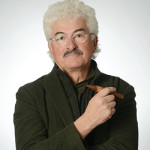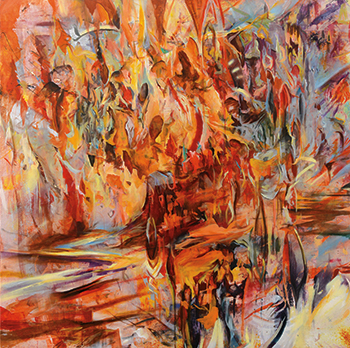Written by Brianne Sanchez
Photos by Duane Tinkey
Styled by Belle Du Chene
 Sharon Hatten
Sharon Hatten
Vintage Souvenir Native American dolls
The collection: “There was one doll that started it,” says Hatten, an artist and a residential staging specialist. “Twenty-five years ago, I was at a flea market, and I saw an Indian doll on a table for a quarter” (top row, left). The doll reminded Hatten of Midwestern childhood vacations, when her grandmother would give her a $5 bill and she’d spend a small amount of the money on a souvenir plastic doll dressed in Native American apparel. The cheerfully clad dolls would keep Hatten, an only child, company in the back seat during road trips.
Popular from the 1920s to the 1960s, the mass-produced souvenir Skookum dolls depicted different Native American tribes and came in various sizes and styles. Over the years, Hatten’s collection has grown to include dozens of the dolls, all picked up for a pittance or received as gifts. “It’s really serendipity,” says Hatten, a fan of flea markets and estate sales. “I adopt ‘orphans’ along the way.”
Spinoff collections: The dolls have also inspired coordinating collections of birch-bark canoes, little wooden totem poles and pottery. “It just seems to amuse me,” Hatten says of the motif. “I’ve always been interested in Native American culture and was intrigued by the way (the dolls) were outfitted.”
Display: “After I got so many, it made sense to line them all up,” Hatten says. “With small multiples of (a similar object), it’s best if you can group them together for visual impact.” Hatten built a small shelf to showcase them, which spilled onto auxiliary shelves as the collection continued to grow.
Why she collects: “I’m driven to (collect) things that evoke an emotion in me, especially from the perspective of art and design,” Hatten says. “I think people should collect things that make them happy. I lean toward more kitschy things.” For Hatten, her many collections—which, in addition to novelty Native American dolls and accessories, include vintage cameras, handbags and fountain pens—are an outlet to express her eclectic taste and also appeal to her sentimental side. “I see things and think, ‘I could be their caretaker,’ ” she says.
 George S. Eichhorn
George S. Eichhorn
Chess Sets
The collection: Eichhorn’s chess set collection spans nearly 50 years, beginning with a ceramic set made by a friend’s mother and a Franklin Mint Civil War set, which pits the Confederacy against the Union. “I like unique, somewhat artistic sets,” says Eichhorn, the general counsel and director of compliance at ChildServe. “It doesn’t matter what they’re made of. I like the memories they bring; some are associated with particular people. There are a lot of years and a lot of memories involved.”
Early interest: Eichhorn has played competitive chess off and on since junior high school. He learned from his brother, Barrie (who’s 15 years older), on a basic plastic set. “By college, I was able to beat him,” Eichhorn says. He also taught and coached scholastic chess and is excited by a resurgence of interest among youths. “It teaches kids thinking skills and doesn’t take a braniac to play,” he says.
International influence: Some of the standout sets in the collection are from trips abroad—either Eichhorn’s own souvenirs or sets brought back by friends and family. One of his favorites is a set Eichhorn’s sister purchased in Athens that represents the ancient Minoan culture (top row, left and middle). The pawns are in the shape of bull’s horns, and the queen wears a ceremonial headdress adorned with snakes, symbols thought to reference the culture’s interest in man’s interaction with powerful natural elements.
Another favorite is a handcrafted wooden set that reflects his profession (middle row). The pieces represent law-related figures and items, such as a sheriff. The king in that set represents an English barrister. “Problem solving is part of my career in law, and chess is a problem-solving adventure,” Eichhorn says.
 Michael LaValle
Michael LaValle
Vintage Cigar Bands
The collection: Purchased at an auction, LaValle’s cigar band collection is contained in a two-ring album, with hundreds of domestic and international bands pasted on yellowing wide-rule paper. News clippings highlighting the original collector—a Wisconsonite named Grover Greasby who amassed more than 40,000 bands but never smoked—also are included. According to a story from a March 1947 edition of The Eugene Register-Guard, Greasby started the collection when he was age 5 (he was 45 at the time of that article), when the 1907 cigar band collecting craze was sweeping the nation. LaValle, the executive chef at the Des Moines Embassy Club and an entrepreneur, hasn’t added any of his own bands, but chose the collection because of its historical and graphic interest.
The cigar connection: LaValle enjoys an occasional cigar (his favorite source is David’s Fine Tobaccos). Although he doesn’t claim to be an aficionado, the cigar culture has provided culinary inspiration. “I put on the first cigar dinner in town,” LaValle says. “A member had gone to a cigar night at the Ritz-Carlton in Los Angeles, and so we decided to do a menu based on cigars, with smoked and Cuban food pairings.”
Self-proclaimed pack rat: “I still own the first car I bought—in 1971,” LaValle says by way of example. He’s a history buff who sees the value in rescuing, retaining and reviving old things, small and large. “My biggest antique is called the John Anderson White Riverboat,” he says. “That’s one (item in the collection) that probably got a little out of control.”
Quest for quality: When LaValle attends an auction, he’s not necessarily looking for something of significant monetary value but “quality is a focus,“ he says. “I’m always trying to find out if something is good.” Items like the cigar band collection or old-school cooking gadgets with history and heft possess an enduring charm that appeals to him. “I think there’s a comfort level to being around things that are real,” LaValle says.
Keeping collections fun: “Most of the time it’s pretty whimsical,” LaValle says of his historical auction purchases, which also include a pastry roller from the Younkers Tea Room and an old-fashioned apple peeler used in a public school kitchen. “It’s nothing I would make into work.”
Ashley Shafer
Vintage and Handcrafted Hats
The collection: Adorned with feathers, beading and netting, and made of fine fabrics such as silk or wool, most of the hats in Shafer’s collection date from the 1950s to the 1970s. “Some of the shapes are just amazing,” says Shafer, a financial adviser for Morgan Stanley. “I need to be fairly conservative in what I wear to work, (so) I don’t really wear any of these hats.” Most are stored in hatboxes displayed in Shafer’s spare bedroom.
The beginning: Shafer says two hats sparked her collection. One is a floppy felted wool hat with a sweetheart shape Shafer made during an internship with a milliner in Chicago (bottom row, left). The other once belonged to her great aunt, who used to let her play dress-up and whose high-end style Shafer
seems to have inherited (top row, left). Her great aunt Emma “actually sold hats in Chicago,” Shafer says. “It’s come full circle.”
The hunt: Shafer seeks out listings for local estate sales, her go-to source for quality hats and vintage finds. Sales hosted by Lloyd’s of Des Moines, Pat Jones Tag Sales and A OK Antiques are a few well-run favorites. “You see a lot of the same people at each (sale),” she says.
Fashion as art: “I truly believe the way people dress is an art form,” Shafer says. She participated in many of the Art Meets Fashion events hosted this past fall by the Des Moines Art Center, including the preview for the “Halston and Warhol: Silver and Suede” exhibit, which featured Jackie Kennedy’s famous pillbox hat from 1961. Like the artist and designer, Shafer’s background includes window design for upscale department stores. A business and studio art double major at Lake Forest College near Chicago, she designed Neiman Marcus windows on Michigan Avenue and for Bergdorf Goodman in New York. “I love high-end fashion, but it’s hard to do in a city like Des Moines,” Shafer says. She feels events like Art Meets Fashion help highlight local ties to important contributions to the fashion industry.













































